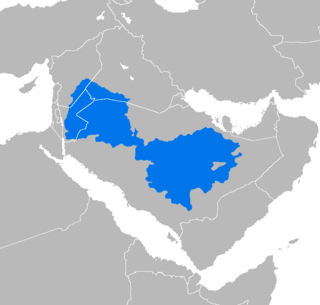|
Najdi Arabic
Najdi Arabic (Arabic: اللهجة النجدية, romanized: al-lahja an-najdiyya, Najdi Arabic: نجدي, Najdi pronunciation: [nadʒˈdi]) is the group of Arabic varieties originating from the Najd region of Saudi Arabia. Outside of Saudi Arabia, it is also the main Arabic variety spoken in the Syrian Desert of Iraq, Jordan, and Syria (with the exception of Palmyra oasis and settlements dotting the Euphrates, where Mesopotamian Arabic is spoken) as well as the westernmost part of Kuwait. Najdi Arabic can be divided into four region-based groups:
PhonologyConsonantsBelow is the table of the consonant phonemes of Najdi Arabic.
Phonetic notes:
Vowels
Unless adjacent to /ɣ x h ħ ʕ/, /a/ is raised in open syllables to [i], [ɨ], or [u], depending on neighboring sounds.[14] Remaining /a/ may become fronted to [æ~ɛ] in the context of front sounds, as well as adjacent to the pharyngeals /ħ ʕ/.[12] Najdi Arabic exhibits the so-called gahawa syndrome, insertion of epenthetic /a/ after (/h x, ɣ ħ, ʕ/). For example, [gahwah] > [gahawah]. When short /a/ appears in an open syllable that is followed by a nonfinal light syllable, it is deleted. For example, /saħab-at/ is realized as [sˈħa.bat].[15] This, combined with the gahawa syndrome can make underlying sequence of /a/ and a following guttural consonant (/h x, ɣ ħ, ʕ/) to appear metathesized, e.g. /ʔistaʕʒal/ ('got in a hurry') [ʔistˈʕaʒal].[16] Short high vowels are deleted in non-final open syllables, such as /tirsil-uːn/ ('you [m. sg.] send') [tirsˈluːn].[17] There is both limited distributional overlap and free variation between [i] and [u], with the latter being more likely in the environment of bilabials, pharyngealized consonants, and /r/.[5] The mid vowels /eː oː/ are typically monophthongs, though they can be pronounced as diphthongs when preceding a plosive, e.g. /beːt/ ('house') [beit].[12] [ei] GrammarMorphologyNajdi Arabic sentence structure can have the word order VSO and SVO, however, VSO usually occurs more often.[18] NA morphology is distinguished by three categories which are: nouns ism, verb fial, and particle harf. Ism means name in Arabic and it corresponds to nouns and adjectives in English. Fial means action in Arabic and it corresponds to verbs. Harf means letter and corresponds to pronouns, demonstratives, prepositions, conjunctions and articles. Verbs are inflected for number, gender, person, tense, aspect and transitives. Nouns show number (singular and plural) and gender (masculine and feminine).[19] Complementizers in NA have three different classes which are: relative particle, declarative particle, and interrogative particles. The three different complementizers that are used in Najdi Arabic are: illi, in, itha.[20] NegationTwo particles are used in negation, which are: ma and la. These particles come before the verb in verbal sentences.[18] ma is used with all verbal sentences but la is used with imperative verb forms indicating present and future tense.[19] Tense/Aspect SystemNajdi Arabic exhibits a number of discourse particles whose main function is to mark different tenses and aspects, including the perfective, imperfective, and progressive aspects. These speech particles "form a link between the time of occurrence of the verb and a point of reference not concurrent with it".[21] [22] cites six "relative time markers":[21]
Most of these discourse particles are preverbal, yet a few of them can show up in non-verbal sentences.[21] These discourse particles have a number of features when they show up in speech:[23]
The following examples illustrate the use of these discourse particles in Najdi Arabic:[24]
ʕaːd-ik still.2SG bduwi bedouin 'you are still a bedouin' ħaːmid Hamid ʕaːd still ʃiftih see.PERF.3SG 'have you seen Hamid any more?'
leːn until sˤirt become.PERF.1SG maː NEG ʕaːd longer aħiss 1SG-feel-IMPERF biʔajj any farɡ difference
'until I could no longer feel any difference' maː NEG ʕaːd longer ʃiftih see.PERF.3SG 'I have not seen him anymore'
baʕad-hum still-3PL jsulifuːn talk.IMPERF.3PL 'they are still talking' baʕad-hum still.3PL hnaj'ja here 'they are still here'
maː NEG baʕad yet ligeːt find.PERF.1SG aħdin anyone jwasˤsˤilha send.IMPERF.3SG 'I have not yet found anyone to send it' ila to l-ħiːn now maː NEG 'baʕad yet garrart decide.PERF.3SG ʃajj thing 'up till now I have not yet decided anything'
taww just nuːrah Nurah hnajja here 'Nurah was just here' taww-ih just.3SG d͡ʒaːj arrive.IMPERF.3SG 'he has just arrived' In addition to these, [d͡zid] ('already') may occur before the main verb[25][page needed] to convey that something has been done but is no longer the case (equivalent to the experiential perfect in English).[26] There are a number of meanings of [d͡zid] depending on context:
The following examples illustrate the use of the particle [d͡zid]:[27] hu he d͡zid EXP ritsib ride.PERF.3SG 'He has ridden' int you d͡zid already d͡ʒiː-ta-hum come.PERF.2SG.3PL gabul before 'You have visited them before' (I think)' maː NEG d͡zid EXP ʃif-t-ih see.PERF.1SG-3SG 'I have never seen him' ana I laħaɡ-t-kum follow.PERF-1SG-2PL laːkin but d͡zid EXP taʕaddeː-tu pass.PER-.2PL l-kullijjah DEF-college 'I came after you, but you had already turned the corner of the college' In addition, the progressive aspect is marked by the particle [qaʕid] ('to sit').[28][page needed][29] The particle [qaʕid] surfaces with a verb in the imperfective aspect but cannot surface with a verb in the perfective aspect, as shown in the following two sentences:[30] ɡaʔid AUX ja-ɡra 3SG.MASC-read.IMPERF al-kitaab DEF.book 'he is reading the book' *ɡaʔid AUX ɡara read.PERF.3SG al-kitaab DEF-book 'he is reading the book' The progressive aspect in Najdi Arabic (as well as other dialects is expressed by the imperfective form of the verb, often preceded by the active particle [qaʕid].Holes (1990)[page needed] The following examples to illustrate the use of [qaʕid] to express the progressive aspect:[31] qaʕid sit.ACT.PTCP.3SG.M aːlʕab play.IPFV.3SG.M kuːrah soccer 'I am playing soccer' qaʕid sit.ACT.PTCP.3SG.M ʔamʃiː walk.IPFV.3SG.M 'I am walking' See alsoFootnotes
Bibliography
Further reading
|
||||||||||||||||||||||||||||||||||||||||||||||||||||||||||||||||||||||||||||||||||||||||||||||||||||||||||||||||||||||||||||||||||||||
